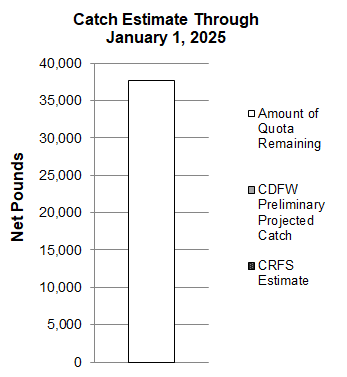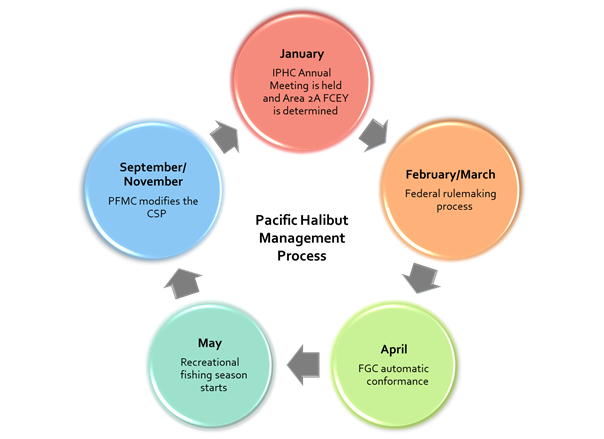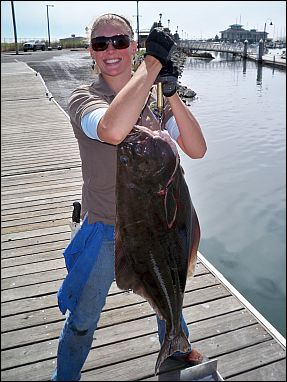Season: The 2025 recreational Pacific halibut fishery opens May 1. In the area north of Point Arena, the fishery is open until November 15. In the area south of Point Arena, the fishery is open through December 31.
Limit: The daily bag and possession limit for Pacific halibut is one fish. There is no minimum size limit.
Methods of Take: When angling, no more than one line with two hooks attached may be used. A harpoon, gaff, or net may be used to assist in taking a Pacific halibut that has been legally caught by angling. See California Code of Regulations Title 14, Section 28.95, for additional restrictions on the use of harpoons. Take by spearfishing is allowed pursuant to California Code of Regulations Title 14, Section 28.90.
Before engaging in fishing activity, check this page for current closure notifications, or you may call either of these hotlines:
- National Marine Fishery Service Halibut Hotline at (800) 662-9825
- CDFW Recreational Pacific Halibut Hotline at (831) 649-2801
Commercial Fishery
For information pertaining to the 2025 commercial season dates, application deadlines and catch limits, please refer to the NOAA Fisheries website.
Pacific Halibut Catch
In-season Tracking "Thermometer"

Projected Pacific Halibut
Catch by Month
| Month |
Net Pounds Accrued |
Preliminary
Projected Catch |
CRFS Estimate |
| May |
3,215 |
1,728 |
| June |
6,162 |
3,910 |
| July |
9,645 |
6,658 |
| August |
4,644 |
4,581 |
| September |
2,054 |
|
| October |
179 |
|
| November |
|
|
| Total |
19,110 |
In the stacked bar chart, the light grey bar represents the total Preliminary Projected Catch in net pounds and dark grey bar represents the total California Recreational Fisheries Survey (CRFS) estimated catch in net pounds. This combined total equates to CDFW’s best estimate of Pacific halibut catch as of the date indicated.
In the table, both the Preliminary Projected Catch values and the CRFS estimates are provided. When CRFS estimate become available, the Preliminary Projected Catch value is reported with a strike-through and is no longer used to estimate quota attainment.
Pacific halibut management is a complex multi-tiered process that involves state, federal and international partners. Since Pacific halibut is an important economic component of fisheries in both the United States of America and Canada, Pacific halibut are managed at an international level under the authority of the North Pacific Halibut Act which is administered through the International Pacific Halibut Commission (IPHC). Each agency is responsible for contributing different aspects of science, research, management, and policy.
The figure below illustrates a simplified version of the annual management process as it applies to California’s recreational Pacific halibut fishery.

January
Each year in late January or early February, the IPHC holds its Annual Meeting where the annual Fishery Catch Exploitable Yield (FCEY) is determined for each IPHC management area based results from the most recent stock assessment. The FCEY, colloquially known as “the quota,” is the amount of fish that each management area is allowed to catch for the year, and it is reported in net pounds of Pacific halibut.
February/March
Once the annual FCEY has been determined, the National Marine Fisheries Service (NMFS) takes over at the federal level. NMFS handles the federal rule-making process which distributes portions of the FCEY to each state and sets fishing season dates as federal law. NMFS collaborates with states agencies on both aspects of the rulemaking process. In late February or early March, CDFW submits the preferred California recreational season dates to NMFS and NMFS makes those season dates federal law.
For IPHC Area 2A, which includes Washington, Oregon, and California, distribution of the FCEY is based on the Area 2A Catch Sharing Plan (CSP). The CSP is an agreement between the three states which is determined through a federal process at the Pacific Fisheries Management Council (PFMC). The three West Coast states in Area 2A negotiate within the framework of the CSP to determine the distribution of the FCEY to tribal and non-tribal fisheries. CDFW takes their constituent’s concerns into consideration while negotiating the CSP.
April
To reduce regulatory complexity, the Fish and Game Commission (FGC) modifies the California Pacific halibut regulations to match, or conform to, the federal regulations published in March. This process is known as automatic conformance.
May
The recreational fishing season typically opens on May 1st. For up-to-date information on this year’s season dates, please see the “Pacific Halibut Regulations” tab.
At this point in the process, the international and federal agencies take a step back. Each state oversees management of their FCEY distribution, or as we like to call it, tracking the quota. CDFW tracks quota attainment to ensure that anglers do not exceed the state’s allotted quota. If the quota has been exceeded, CDFW will coordinate with NMFS and IPHC to close the California fisheries.
September/November
At the September PFMC meeting, proposals for modifications to the CSP are presented. At this time, the public can make suggestions to CDFW about changes to the CSP and CDFW may bring those proposals to the PFMC. Final adoption of changes to the CSP are determined at the November PFMC meeting, and these changes apply to the following year’s fisheries.
To learn more, contact one of these contributing agencies:

Q: What are the recreational season dates this year?
A: The recreational Pacific halibut season opens May 1, 2025. Please check the “In-season Tracking” tab above to see the current estimate of catch for the prior season. Visit the Current California Ocean Recreational Fishing Regulations page for northern California for an up-to-date status of whether the fishery is open or closed.
Q: Are there other regulations for recreational Pacific halibut fishing?
A: There is a daily bag limit of one fish for Pacific halibut. When angling, no more than one line with two hooks attached may be used. A harpoon, gaff, or net may be used to assist in taking a Pacific halibut that has been legally caught by angling. See California Code of Regulations Title 14, Section 28.95, for additional restrictions on the use of harpoons. Take by spearfishing is allowed pursuant to California Code of Regulations Title 14, Section 28.90.
For more information about Pacific halibut regulations, see the CDFW sport fishing regulation booklet.
Q: How is the recreational California quota determined?
A: The International Pacific Halibut Commission determines the quota for each management area. In Area 2A, which includes Washington, Oregon, and California, quota is distributed by the National Marine Fisheries Service according to a Catch Sharing Plan (CSP). The three states negotiate and agree to the CSP. Under the current CSP, the California recreational fishery receives 4.0 percent of the non-tribal portion of the Area 2A quota. For a more in-depth explanation, please see the “Pacific Halibut Management Process” tab.
Q: Where can I read or download the Catch Sharing Plan?
A: You can find the most recent Catch Sharing Plan on the PFMC’s Pacific halibut web page.
Q: How can the public voice their opinion and get involved with the Pacific halibut regulatory process?
A: The most effective way for the public to get involved is to voice your opinion about the Catch Sharing Plan (CSP). The CSP governs quota distribution and fishing regulations for Washington, Oregon, and California and it is negotiated as part of the Pacific Fisheries Management Council (PFMC) process. Every September, the PFMC asks for proposals to modify the CSP. This is the time and place where CDFW can get the ball rolling on changes to the CSP.
Make your voice heard prior to the September PFMC meeting:
Q: Where are the regulations for commercial Pacific halibut fishing?
A: Commercial Pacific halibut fishing in California is managed by NOAA Fisheries. For more information, visit the NOAA Fisheries page on commercial fishing.
Q: Is there a difference between state and federal regulations for Pacific halibut?
A: No. State regulations for Pacific halibut conform to federal regulations for Pacific halibut.